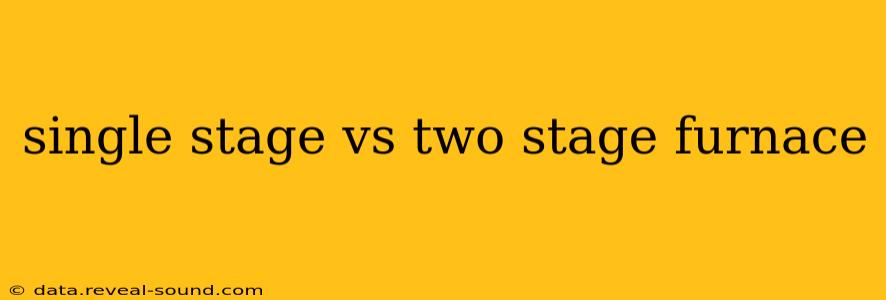Choosing the right furnace is a crucial decision for homeowners, impacting both comfort and energy bills. Two main types dominate the market: single-stage and two-stage furnaces. Understanding their differences is key to making an informed choice. This comprehensive guide will delve into the specifics of each, helping you determine which furnace best suits your needs and budget.
What is a Single-Stage Furnace?
A single-stage furnace operates in a simple on/off manner. When the thermostat calls for heat, the blower motor and burner ignite at full capacity. It runs at 100% until the desired temperature is reached, then shuts off completely. Think of it like a light switch: either fully on or fully off. This straightforward design is generally less expensive to purchase and simpler to maintain.
What is a Two-Stage Furnace?
A two-stage furnace offers more nuanced control over heating. It operates at two different levels: a low-stage setting (approximately 40% capacity) and a high-stage setting (100% capacity). The furnace cycles between these stages based on the temperature difference between the set point and the actual room temperature. This allows for more precise temperature regulation and a more comfortable indoor environment.
Single Stage vs. Two Stage Furnace: Key Differences
| Feature | Single-Stage Furnace | Two-Stage Furnace |
|---|---|---|
| Operation | On/off, 100% capacity | Two stages: low (40%) and high (100%) capacity |
| Temperature Control | Less precise, more temperature swings | More precise, minimizes temperature fluctuations |
| Comfort Level | Can lead to temperature fluctuations | More consistent and comfortable temperature |
| Energy Efficiency | Generally less energy-efficient | Potentially more energy-efficient |
| Lifespan | Comparable lifespan to two-stage furnaces | Comparable lifespan to single-stage furnaces |
| Cost | Typically less expensive to purchase | Typically more expensive to purchase |
| Maintenance | Generally simpler maintenance | Slightly more complex maintenance |
How Does a Two-Stage Furnace Save Energy?
The energy-saving benefits of a two-stage furnace stem from its ability to maintain a consistent temperature using its lower setting. By running at a lower capacity for longer periods, it reduces the frequency and duration of high-intensity heat output. This minimizes energy waste associated with the rapid heating and cooling cycles of a single-stage unit. While the initial cost is higher, the long-term energy savings can offset this difference over time.
Which Furnace is More Comfortable?
Two-stage furnaces generally offer a more comfortable living environment. The smaller, more frequent temperature adjustments help maintain a consistent temperature, preventing the noticeable temperature swings common with single-stage units. This leads to a more stable and pleasant indoor climate.
Is a Two-Stage Furnace More Reliable?
Both single-stage and two-stage furnaces boast comparable reliability. Regular maintenance is crucial for both types to ensure optimal performance and longevity. The slightly more complex components of a two-stage furnace might require slightly more specialized maintenance, but this is usually negligible.
How Much Does Each Type of Furnace Cost?
Single-stage furnaces typically have a lower upfront cost. Two-stage furnaces have a higher initial investment due to their more sophisticated design and components. However, the long-term energy savings of a two-stage furnace can often make up for the higher purchase price over the lifespan of the unit.
What Size Furnace Do I Need?
Determining the appropriate size furnace for your home involves several factors, including the size of your home, insulation levels, climate, and the number of windows. It's crucial to get a professional assessment to determine the correct BTU (British Thermal Units) rating. An improperly sized furnace, whether too large or too small, will impact energy efficiency and comfort.
How Often Should I Get My Furnace Serviced?
Regular furnace maintenance is essential regardless of the type of furnace you have. Annual inspections and servicing by a qualified HVAC technician are recommended to ensure optimal performance, identify potential problems early, and extend the lifespan of your system. This preventative maintenance will also help improve energy efficiency and contribute to greater comfort.
This information should help you make a more informed decision about which type of furnace best fits your individual needs and budget. Consulting with an HVAC professional is highly recommended before making a final purchase.
